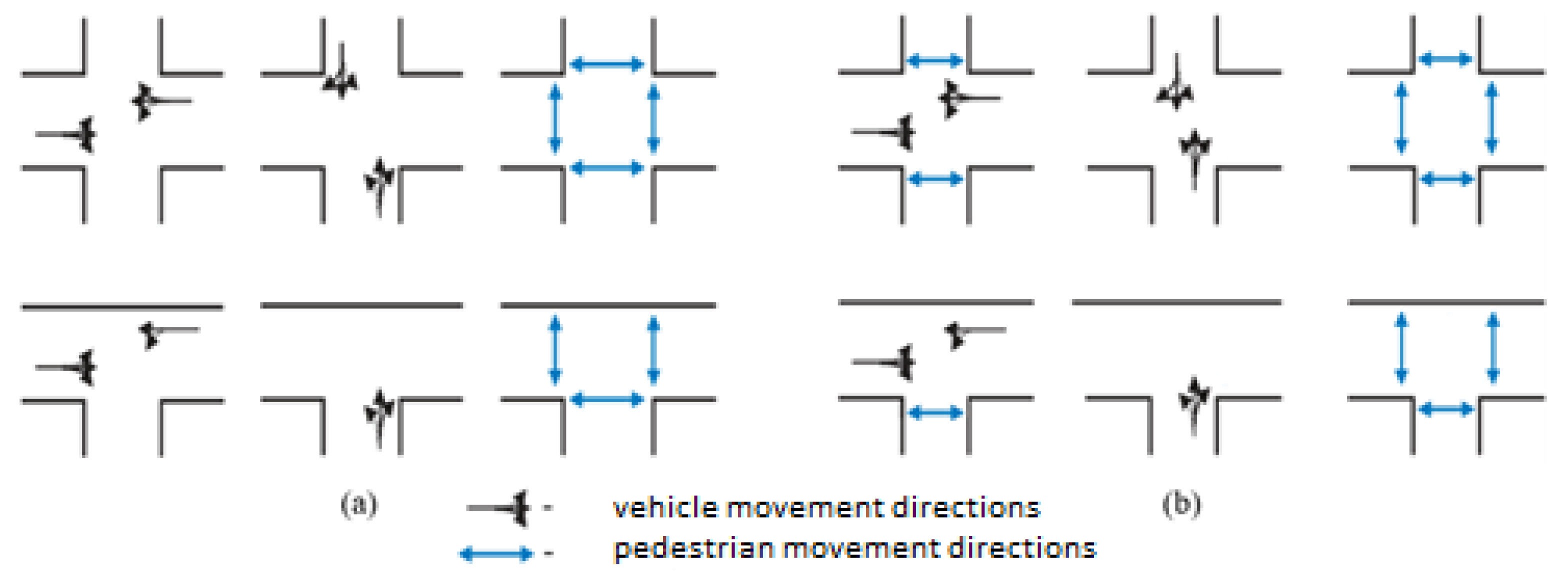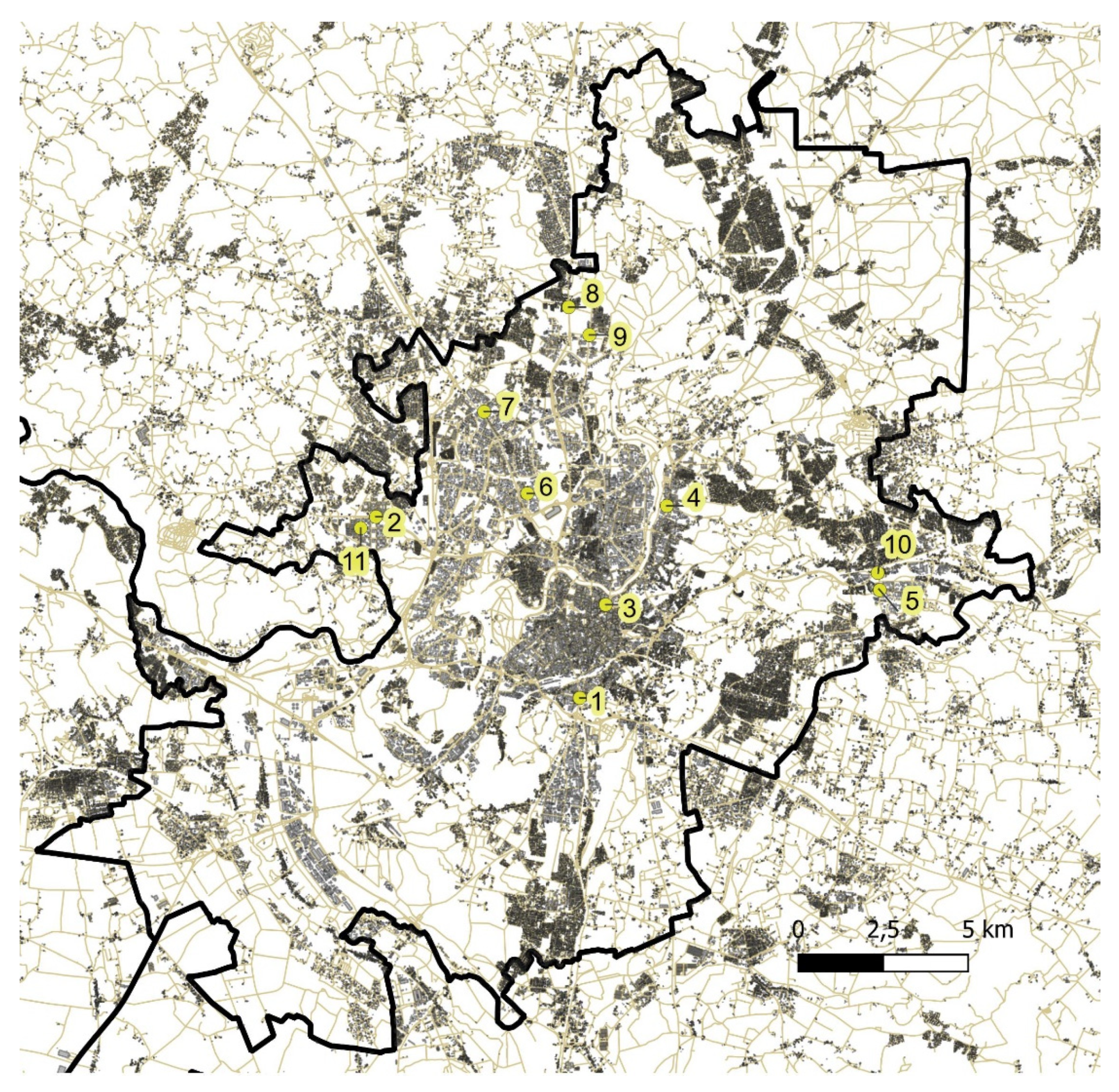Evaluation of Exclusive Pedestrian Phase Safety Performance at One-Level Signalized Intersections in Vilnius
Abstract
1. Introduction
2. Materials and Methods
- (a)
- An exclusive pedestrian phase was installed in the traffic light control cycle, during which pedestrians could cross intersections in four directions (diagonal crossing was prohibited). Pedestrian traffic was not allowed during vehicle movement phases. This type of control was used to ensure pedestrian safety when a large number of vehicles turn around (see Figure 1a).
- (b)
- An exclusive pedestrian phase was installed in the traffic light control cycle, during which pedestrians could cross the intersection in four directions (diagonal crossing was prohibited). During the vehicle movement phase (on the main street), pedestrian traffic was allowed together with vehicles moving in parallel. This type of control was implemented to reduce the waiting time for pedestrians at pedestrian crossings when there were few vehicles turning (see Figure 1b).
3. Results of the AD Analysis
4. Discussion
5. Conclusions
- Researchers indicated that the introduction of an exclusive pedestrian phase with a diagonal crossing was quite a popular safety measure, and reduced the number of pedestrian–vehicle conflicts and accidents on average by 66%. Research in the literature has shown that an exclusive pedestrian phase reduced the average pedestrian distance at an intersection from 5% to 13%.
- The best practice of foreign countries has shown that proper public information about the introduction of an exclusive pedestrian phase with a diagonal crossing at the intersection is essential to ensure the proper behavior of all road users. The examples provided and the surveys conducted have shown that well-informed pedestrians know how to behave at an intersection and understand the exact benefits of such changes. It is noticeable that the exclusive pedestrian phase with a diagonal crossing can cause difficulties for visually impaired and blind individuals; therefore, it is very important to identify solutions to help people with visual impairments.
- After the analysis of Vilnius’ intersections, it was found that two specific types of exclusive pedestrian phases are used at the intersection (diagonal crossing is prohibited). The first type is when pedestrian traffic takes place only during the exclusive phase. The second type is when pedestrian traffic takes place not only during the exclusive pedestrian phase, but also during the main transport phases on the street, moving in parallel with vehicles. An analysis of the urban land use environment revealed that such intersections with exclusive pedestrian phases are located in residential areas of high or medium intensity, or in city district centers with mixed high intensity areas. There are also large grocery stores, educational or medical facilities, and public transport stops near such intersections.
- The density of pedestrian-related accidents at existing intersections with specific exclusive pedestrian phases in Vilnius decreased by up to 100% after the introduction of the exclusive pedestrian phase. No traffic accidents occurred after the installation of the exclusive pedestrian phase at intersections where there were no accidents before the installation, and no adverse effects on traffic safety were observed. The one-level signalized intersections with the exclusive pedestrian phase without the possibility of diagonal crossing gives a positive impact on traffic safety, and may be used as a substitute to similar intersections with the possibility of diagonal crossing where technical or legal obstacles arise. However, the study may be subject to a small sample size problem, but with the further introduction of such specific pedestrian phases in Vilnius, it will be possible to analyze a larger data sample and cover longer periods.
Author Contributions
Funding
Institutional Review Board Statement
Informed Consent Statement
Data Availability Statement
Conflicts of Interest
References
- World Health Organization. Global Status Report on Road Safety 2018: Summary; World Health Organization: Geneva, Switzerland, 2018. [Google Scholar]
- World Health Organization. Road Traffic Injuries. Available online: https://www.who.int/news-room/fact-sheets/detail/road-traffic-injuries (accessed on 11 October 2021).
- Hamidun, R.; Kordi, N.E.; Endut, I.R.; Ishak, S.Z.; Yusoff MF, M. Estimation of illegal crossing accident risk using stochastic petri nets. J. Eng. Sci. Technol. 2015, 10, 81–93. [Google Scholar]
- Siddiqui, C.; Abdel-Aty, M.; Choi, K. Macroscopic spatial analysis of pedestrian and bicycle crashes. Accid. Anal. Prev. 2012, 45, 382–391. [Google Scholar] [CrossRef] [PubMed]
- Pulugurtha, S.S.; Sambhara, V.R. Pedestrian crash estimation models for signalized intersections. Accid. Anal. Prev. 2011, 43, 439–446. [Google Scholar] [CrossRef] [PubMed]
- Miranda-Moreno, L.F.; Morency, P.; El-Geneidy, A.M. The link between built environment, pedestrian activity and pedestrian–vehicle collision occurrence at signalized intersections. Accid. Anal. Prev. 2011, 43, 1624–1634. [Google Scholar] [CrossRef] [PubMed]
- King, M.J.; Soole, D.; Ghafourian, A. Illegal pedestrian crossing at signalised intersections: Incidence and relative risk. Accid. Anal. Prev. 2009, 41, 485–490. [Google Scholar] [CrossRef] [PubMed]
- Hamidun, R.; Ishak, S.Z.; Kordi, N.E.; Endut, I.R. Prediction of pedestrian risk at signalized intersections. J. Teknol. 2016, 78. [Google Scholar] [CrossRef][Green Version]
- Young, K.L.; Salmon, P.M.; Lenné, M.G. At the cross-roads: An on-road examination of driving errors at intersections. Accid. Anal. Prev. 2013, 58, 226–234. [Google Scholar] [CrossRef] [PubMed]
- Federal Highway Administration. Where Was the First Walk/Don’t Walk Sign Installed? Available online: https://www.fhwa.dot.gov/infrastructure/barnes.cfm (accessed on 11 October 2021).
- Bloomberg CityLab. A Brief History of the Barnes Dance. Available online: https://www.bloomberg.com/news/articles/2012-12-18/a-brief-history-of-the-barnes-dance (accessed on 12 October 2021).
- Vaziri, B. Exclusive Pedestrian Phase for the Business District Signals in Beverly Hills: 10 Years Later. In 1998 Compendium of Technical Papers; Institute of Transportation Engineers: Washington, DC, USA, 1998. [Google Scholar]
- Tu, D.R. Exclusive pedestrian control for Dunedin’s central business district. In Transportation and Traffic Engineering Group, Proceedings of the Technical Session of the Group at the Annual Conference of IPENZ, Auckland, New Zealand, 8 February 1982; Institution of Professional Engineers New Zealand: Wellington, New Zealand, 1982; pp. 8–12. [Google Scholar]
- Bechtel, A.K.; Macleod, K.E.; Ragland, D.R. Pedestrian scramble signal in Chinatown neighborhood of Oakland, California: An evaluation. Transp. Res. Rec. 2004, 1878, 19–26. [Google Scholar] [CrossRef]
- Tu, T.V.; Sano, K. Simulation based analysis of scramble crossings at signalized intersections. Int. J. Transp. 2014, 2, 1–14. [Google Scholar] [CrossRef]
- Zhang, Y.; Su, R. Pedestrian phase pattern investigation in a traffic light scheduling problem for signalized network. In Proceedings of the 2018 IEEE Conference on Control Technology and Applications (CCTA), Copenhagen, Denmark, 21–24 August 2018; pp. 608–613. [Google Scholar]
- Kattan, L.; Acharjee, S.; Tay, R. Pedestrian scramble operations: Pilot study in Calgary, Alberta, Canada. Transp. Res. Rec. 2009, 2140, 79–84. [Google Scholar] [CrossRef]
- Mahmud, M.; Magalotti, M.J. Comparing the Operational Efficiency of Signalized Intersections with Exclusive and Concurrent Pedestrian Phase Operations Considering Pedestrian Non-Compliance. Ph.D. Thesis, University of Pittsburgh, Pittsburgh, PA, USA, 2018. [Google Scholar]
- McKernan, K.R. A Study of Pedestrian Compliance with Traffic Signals Exclusive and Concurrent Phasing. In Proceedings of the Transportation Research Board Annual Meeting, Washington, DC, USA, 10–14 January 2016. [Google Scholar]
- City of Toronto. Pedestrian Scramble Crossings—A Tale of Two Cities. Available online: https://www.toronto.ca/wp-content/uploads/2017/11/8eee-pedestrian_scramble_crossings.pdf (accessed on 13 October 2021).
- Al-Ghamdi, A.S. Pedestrian–vehicle crashes and analytical techniques for stratified contingency tables. Accid. Anal. Prev. 2002, 34, 205–214. [Google Scholar] [CrossRef]
- Nash, D.; Smith, W. The efficiency of scramble crossings. In Proceedings of the Australian Institute of Traffic Planning and Management (AITPM) National Conference, Brisbane, Australia, 21 July 2010. [Google Scholar]
- Uhlmann, J. Comparison of road traffic death and injury rates at pedestrian crossings in Europe. Balt. J. Road Bridge Eng. 2021, 16, 16–29. [Google Scholar] [CrossRef]
- Szagala, P.; Brzezinski, A.; Kiec, M.; Budzynski, M.; Wachnicka, J.; Pazdan, S. Pedestrian Safety at Midblock Crossings on Dual Carriageway Roads in Polish Cities. Sustainability 2022, 14, 5703. [Google Scholar] [CrossRef]
- The Department of Statistics. Population and Social Statistics. 2020. Available online: https://osp.stat.gov.lt/ (accessed on 13 November 2021).
- Lithuanian Police Department. Open Data on Traffic Accidents with People Killed and Injured in Lithuania. Available online: https://policija.lrv.lt/lt/paslaugos/atviri-duomenys-1-1 (accessed on 13 December 2021).
- Lithuanian Road Administration under the Lithuanian Ministry of Transport and Communications. Road Investment Manual. Available online: https://e-seimas.lrs.lt/portal/legalAct/lt/TAD/d6eb55a0948011e59c9a8f8c9980906b?jfwid=fhhu5mh5f (accessed on 12 December 2021).
- Lithuanian Ministry of Transport and Communications. Description of Requirements and Procedures for the Detection, Examination and Removal of Black Spots. Available online: https://e-seimas.lrs.lt/portal/legalAct/lt/TAD/faf403307fb011ecb2fe9975f8a9e52e?jfwid=32wf6dzs (accessed on 12 December 2021).
- Zhang, Y.; Mamun, S.A.; Ivan, J.N.; Ravishanker, N.; Haque, K. Safety effects of exclusive and concurrent signal phasing for pedestrian crossing. Accid. Anal. Prev. 2015, 83, 26–36. [Google Scholar] [CrossRef]
- Government of South Australia, Department of Planning, Transport and Infrastructure. Scramble Pedestrian Crossings. Available online: https://www.dit.sa.gov.au/__data/assets/pdf_file/0019/40177/Operational_Instruction_14_1.pdf (accessed on 13 December 2021).


| Pedestrians | Vehicle Drivers | |
|---|---|---|
| Advantages |
|
|
| Disadvantages |
|
|
| No. | Name of the Intersection | Traffic Accidents | Year of the Implementation of Exclusive Pedestrian Phase | |||
|---|---|---|---|---|---|---|
| With People Killed before Implementation (A1) | With People Injured before Implementation (A2) | With People Killed after Implementation (A1) | With People Injured after Implementation (A2) | |||
| 1. | Dariaus ir Girėno—Šaltkalvių—Kapsų g. | 0 | 8 | 0 | 3 | 2016 |
| 2. | Pilaitės pr.—Įsruties g. | 0 | 0 | 0 | 0 | End of 2016 |
| 3. | Gedimino pr.—Šventaragio—T. Vrublevskio g. | 0 | 2 | 0 | 1 | July 2016 |
| 4. | Antakalnio—Žolyno g. | 0 | 1 | 0 | 0 | July 2016 |
| 5. | Parko—Pergalės g. | 1 | 2 | 0 | 0 | End of 2017 |
| 6. | Šeškinės—Paberžės g. | 0 | 0 | 0 | 0 | August 2018 |
| 7. | S. Neries g. 14 next to shopping center | 0 | 0 | 0 | 0 | 2016 |
| 8. | Molėtų—Skersinės g. | 0 | 1 | 0 | 0 | 2015 |
| 9. | Santariškių—Santaros g. | 0 | 0 | 0 | 0 | 2018 |
| 10. | Pergalės-Pramonės g. | 0 | 0 | 0 | 0 | July 2016 |
| 11. | Vydūno-Karaliaučiaus g. | 0 | 0 | 0 | 0 | 2018 |
| No. and Type | Name of the Intersection | Number of Years before/after Implementation | AD | Change in AD, % | |
|---|---|---|---|---|---|
| Before | After | ||||
| Dariaus ir Girėno—Šaltkalvių—Kapsų g. | 3 | 2.67 | 1.00 | −62.6 |
| Pilaitės pr.—Įsruties g. | n/a | 0 | 0 | 0 |
| Gedimino pr.—Šventaragio—T. Vrublevskio g. | 3.5 | 0.57 | 0.29 | −49.1 |
| Antakalnio—Žolyno g. | 3.5 | 0.29 | 0 | −100.0 |
| Parko—Pergalės g. | 3.5 | 3.71 | 0 | −100.0 |
| Šeškinės—Paberžės g. | n/a | 0 | 0 | 0 |
| S. Neries g. 14 next to shopping center | n/a | 0 | 0 | 0 |
| Molėtų—Skersinės g. | 2 | 0.5 | 0 | −100.0 |
| Santariškių—Santaros g. | n/a | 0 | 0 | 0 |
| Pergalės-Pramonės g. | n/a | 0 | 0 | 0 |
| Vydūno-Karaliaučiaus g. | n/a | 0 | 0 | 0 |
Publisher’s Note: MDPI stays neutral with regard to jurisdictional claims in published maps and institutional affiliations. |
© 2022 by the authors. Licensee MDPI, Basel, Switzerland. This article is an open access article distributed under the terms and conditions of the Creative Commons Attribution (CC BY) license (https://creativecommons.org/licenses/by/4.0/).
Share and Cite
Juozevičiūtė, D.; Grigonis, V. Evaluation of Exclusive Pedestrian Phase Safety Performance at One-Level Signalized Intersections in Vilnius. Sustainability 2022, 14, 7894. https://doi.org/10.3390/su14137894
Juozevičiūtė D, Grigonis V. Evaluation of Exclusive Pedestrian Phase Safety Performance at One-Level Signalized Intersections in Vilnius. Sustainability. 2022; 14(13):7894. https://doi.org/10.3390/su14137894
Chicago/Turabian StyleJuozevičiūtė, Dainora, and Vytautas Grigonis. 2022. "Evaluation of Exclusive Pedestrian Phase Safety Performance at One-Level Signalized Intersections in Vilnius" Sustainability 14, no. 13: 7894. https://doi.org/10.3390/su14137894
APA StyleJuozevičiūtė, D., & Grigonis, V. (2022). Evaluation of Exclusive Pedestrian Phase Safety Performance at One-Level Signalized Intersections in Vilnius. Sustainability, 14(13), 7894. https://doi.org/10.3390/su14137894







